Types of Data Centers: Finding the Ideal Solution
After exploring the fundamental components that make up a data center, it is time to delve
into the diversity of options available in today's market. Choosing the right type of data center
can determine the success or failure of an organization's technology strategy.
In the current landscape, companies face critical decisions about where and how to host their
IT infrastructure. Each model presents unique advantages, differentiated costs, and variable levels of control.
Understanding these options is essential to making informed decisions that align
with business objectives, available budget, and specific technical requirements.
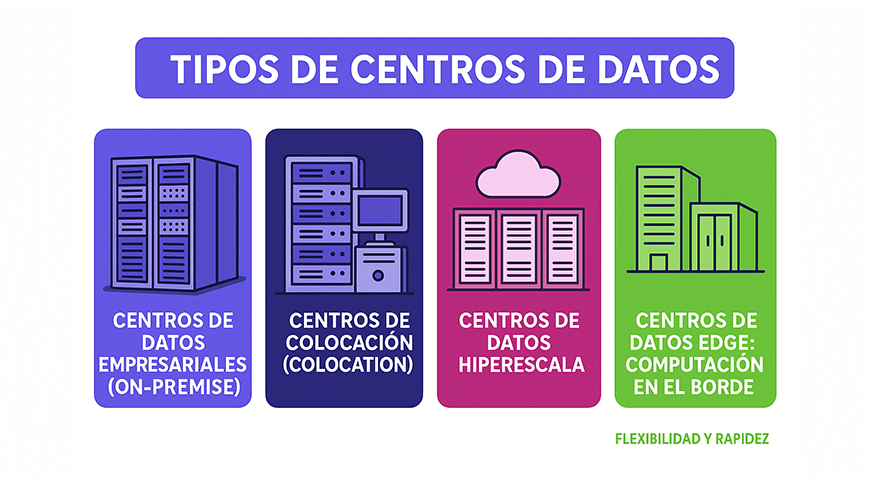
1. On-Premise Data Centers
On-premise data centers, also known as enterprise data centers, represent the
traditional modality where organizations own, build, and operate their own IT facilities within
their buildings or grounds.
Main characteristics:
-
Total control: The organization maintains absolute control over all aspects of
the infrastructure, from hardware to security policies.
-
Complete customization: Ability to design the infrastructure according to specific
needs without external restrictions.
-
Regulatory compliance: Facilitates compliance with strict regulations by
keeping all data within the organizational perimeter.
-
Minimum latency: Direct access to resources without dependence on
external connections.
Advantages:
-
Maximum security and privacy: Data never leaves the direct control of the
organization.
-
Predictable performance: There is no competition for resources with other users.
-
Legacy integration: Ideal for legacy systems that require specific
configurations.
-
Predictable operating costs: Once implemented, costs are relatively
stable.
Disadvantages:
-
High initial investment: Requires significant capital for construction and
equipment.
-
Limited scalability: Expanding capacity requires additional investment in
physical infrastructure.
-
Operational complexity: Need for specialized personnel for management and
maintenance.
-
Risk of obsolescence: Equipment can become outdated quickly.
This model is ideal for organizations with sufficient resources, specific
regulatory compliance needs, and predictable workloads that justify the initial investment.
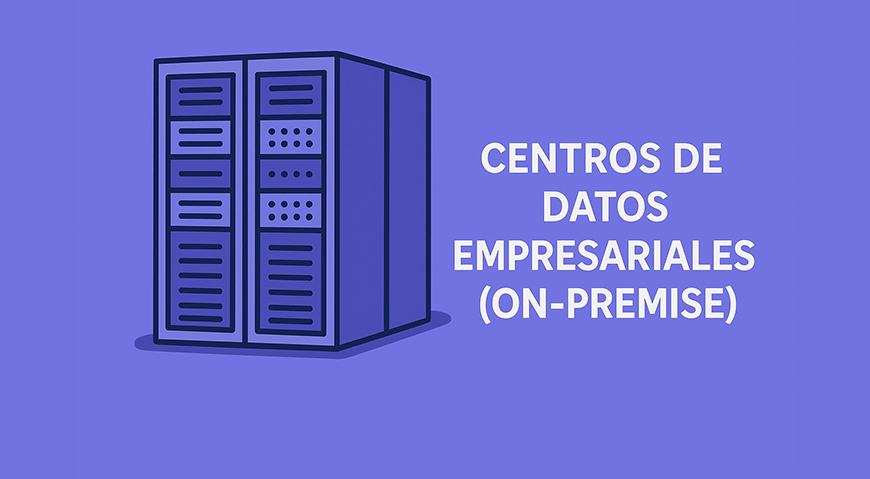
2. Colocation Data Centers
Colocation centers offer a hybrid model where organizations own their servers and
equipment, but host them in specialized facilities operated by third parties. This model combines
control over hardware with the benefits of shared infrastructure.
Colocation modalities:
-
Full rack colocation: The organization rents entire racks for its exclusive
equipment.
-
Half rack colocation: Economical option for smaller space needs.
-
Cage colocation: Fenced spaces for greater security and organization of
multiple racks.
-
Private suites: Completely independent spaces within the
colocation center.
Services typically included:
-
Redundant power: UPS systems and backup generators.
-
Specialized cooling: HVAC systems optimized for IT equipment.
-
Multiple connectivity: Access to various internet and
telecommunications providers.
-
Physical security: Biometric access control, video surveillance, and security
personnel.
-
Hands & Eyes: Basic technical services for rebooting, visual verification, and simple
replacements.
Advantages of the colocation model:
-
CAPEX reduction: Avoids investment in construction and support infrastructure.
-
Professional infrastructure: Access to enterprise-grade facilities without the
full investment.
-
Gradual scalability: Ability to expand space as needed.
-
Carrier diversity: Multiple connectivity options and provider
redundancy.
Colocation is especially attractive for companies that want to maintain control over their
hardware while benefiting from professional infrastructure and strategic locations near
major connectivity hubs.

3. Cloud Data Centers
Cloud data centers represent the evolution towards fully managed services,
where providers offer computational resources as on-demand services. This model has
revolutionized the way organizations consume IT infrastructure.
Cloud service models:
-
Infrastructure as a Service (IaaS): Virtualization of basic resources such as
computing, storage, and network.
-
Platform as a Service (PaaS): Development and deployment platforms for applications.
-
Software as a Service (SaaS): Complete applications accessible via the web.
-
Function as a Service (FaaS): Code execution without server management
(serverless).
Deployment types:
-
Public cloud: Shared resources accessible to multiple customers (AWS, Azure,
Google Cloud).
-
Private cloud: Infrastructure dedicated exclusively to one organization.
-
Hybrid cloud: Combination of public and private resources with integration between
both.
-
Multi-cloud: Use of multiple cloud providers to avoid dependence on
a single vendor.
Main benefits:
-
Elastic scalability: Ability to increase or decrease resources according to demand in
real time.
-
Pay-per-use model: Variable costs based on actual resource consumption.
-
Global availability: Access to resources from multiple geographic regions.
-
Managed services: Reduction of operational burden through fully
managed services.
-
Accelerated innovation: Quick access to new technologies and services.
The cloud has become the preferred option for startups and companies seeking agility,
scalability, and reduction of operational complexity, although it requires careful cost management and
optimization strategies.

4. Hyperscale Data Centers
Hyperscale data centers represent the pinnacle of efficiency and scalability in
IT infrastructure. These massive facilities are designed to support the demands of
tech giants and cloud service providers.
Distinctive features:
-
Massive scale: Facilities that can house tens of thousands of servers in
spaces of more than 100,000 square meters.
-
Extreme automation: Automated management of virtually all operational
processes.
-
Optimized energy efficiency: PUE (Power Usage Effectiveness) typically less than
1.2.
-
Modular design: Phased construction that allows for gradual expansion as needed.
-
Custom commodity hardware: Servers designed specifically to maximize
efficiency.
Technologies implemented:
-
Software-Defined Infrastructure: Complete virtualization of network, storage,
and computing resources.
-
Liquid cooling: Advanced cooling systems to manage high heat
densities.
-
Renewable energies: Integration of solar, wind, and other
renewable energy sources.
-
AI for operations: Machine learning for predictive optimization and failure
prevention.
Main operators:
-
Public hyperscalers: Amazon (AWS), Microsoft (Azure), Google (GCP), Meta
(Facebook).
-
Specialized providers: Digital Realty, Equinix, CyrusOne, QTS.
-
Regional operators: Companies that operate hyperscale centers in specific
regions.
Although these centers are typically beyond the reach of individual companies as owners, their
impact is felt through the cloud services they provide, offering previously
unthinkable capabilities at affordable costs.
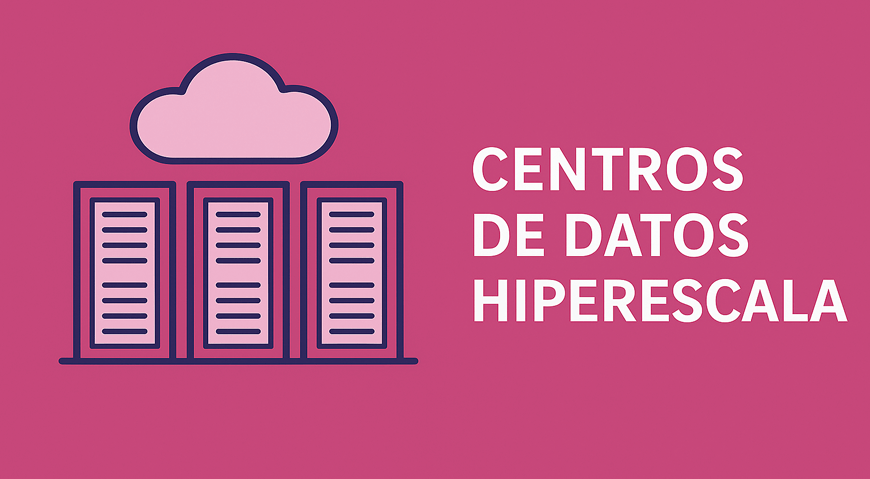
5. Edge Data Centers: Computing at the Edge
Edge data centers represent the trend towards decentralization, placing
computational resources closer to end users and IoT devices to reduce latency and improve
user experience.
Classification by proximity:
-
Regional Edge: Medium-sized centers located in major cities to serve
metropolitan areas.
-
Local Edge: Small facilities in neighborhoods or business districts.
-
Far Edge: Micro data centers integrated directly into
telecommunications towers or buildings.
-
Device Edge: Computational capacity integrated into end devices such as industrial
routers.
Main use cases:
-
Low-latency applications: Online gaming, high-frequency trading, virtual/augmented
reality.
-
IoT and Industrial: Local processing of sensors, smart manufacturing, smart
cities.
-
Content Delivery: Local caching of multimedia content and web applications.
-
Autonomous vehicles: Local processing for critical safety decisions.
Technical characteristics:
-
Compact size: From individual cabinets to prefabricated containers.
-
Autonomous operation: Ability to function with minimal human intervention.
-
Environmental resistance: Robust design for uncontrolled environments.
-
5G connectivity: Integration with new generation networks for mobile applications.
Edge computing is experiencing explosive growth, driven by ultra-low
latency requirements, data privacy regulations, and the proliferation of connected devices that
generate massive volumes of local data.
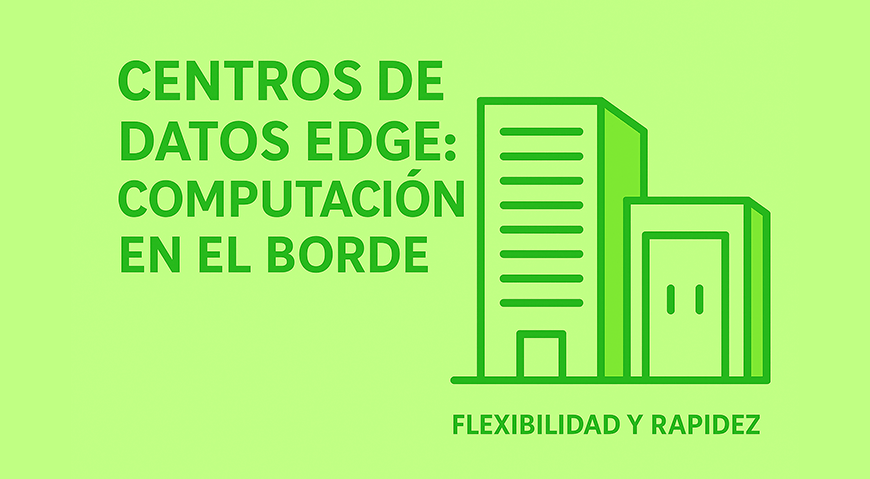
6. Modular Data Centers: Flexibility and Speed
Modular data centers offer an innovative alternative to traditional construction,
providing prefabricated infrastructure that can be deployed quickly according to changing
business needs.
Types of modules:
-
Standard containers: Based on 20 or 40-foot shipping containers, ideal
for rapid deployments.
-
Custom modules: Structures designed specifically for particular
requirements.
-
Micro modules: Compact units for indoor installation in existing spaces.
-
Support modules: Specialized units for power, cooling, or
telecommunications.
Integrated components:
-
Power systems: Integrated UPS, power distribution, and backup.
-
Cooling: HVAC systems optimized for the available space.
-
Physical security: Built-in access control and monitoring.
-
Remote management: Monitoring systems for unattended operation.
Competitive advantages:
-
Accelerated deployment: Installation in weeks instead of months or years.
-
Incremental scalability: Addition of capacity module by module as needed.
-
Portability: Ability to relocate the infrastructure if necessary.
-
Predictable costs: Fixed price known before deployment.
-
Energy efficiency: Optimized design for maximum efficiency in a small space.
Modular centers are especially attractive for organizations that need rapid capacity,
have temporary or remote locations, or require flexibility to reconfigure their infrastructure
according to business changes.
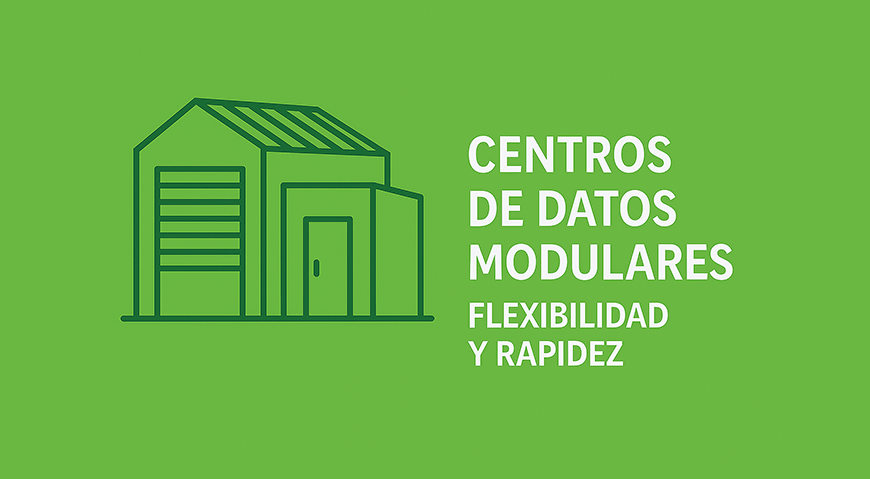
Selection Criteria: Finding the Perfect Solution
Choosing the right type of data center requires a careful analysis of multiple factors
ranging from technical considerations to budgetary constraints and strategic
business objectives.
Key technical factors:
-
Latency requirements: Critical applications may require physical proximity or
edge centers.
-
Data volume: Large volumes may favor colocation or
hyperscale solutions.
-
Load patterns: Variable loads benefit from the elasticity of the cloud.
-
Integration with existing systems: Legacy systems may require
on-premise solutions.
Economic considerations:
-
CAPEX vs OPEX: Evaluation of the financial model preferred by the organization.
-
TCO (Total Cost of Ownership): Complete cost analysis over 3-5 years.
-
Cost scalability: How costs scale with the growth of needs.
-
Hidden costs: Migration, training, management, and service exit.
Compliance and risk factors:
-
Specific regulations: GDPR, HIPAA, PCI-DSS, and other applicable regulations.
-
Data sovereignty: Requirements to keep data in specific jurisdictions.
-
Business continuity: Tolerance for interruptions and availability requirements.
-
Vendor lock-in: Evaluation of dependence on specific providers.
Organizational capabilities:
-
Internal technical expertise: Availability of specialized personnel for management.
-
Management resources: Ability to supervise and maintain infrastructure.
-
IT strategy: Alignment with the company's overall technology direction.
-
Risk appetite: Tolerance for new technologies vs. proven solutions.
Recommendations by scenario:
For startups and agile companies: The public cloud offers scalability without
initial investment, allowing focus on the core business.
For established companies with predictable loads: Colocation can offer the
ideal balance between control and operational efficiency.
For highly regulated organizations: On-premise centers or private clouds may be
necessary for strict compliance.
For real-time applications: Edge centers are essential to minimize latency and
improve user experience.
The current trend points towards hybrid architectures that combine multiple types of data
centers, optimizing each workload according to its specific requirements. This approach allows
maximizing benefits while minimizing the limitations of any single model.
The continuous evolution of the technological landscape requires flexibility in
infrastructure decisions. The most successful organizations are those that maintain portability in their
architectures, allowing adaptation to new opportunities and changes in business requirements without
significant disruption.

